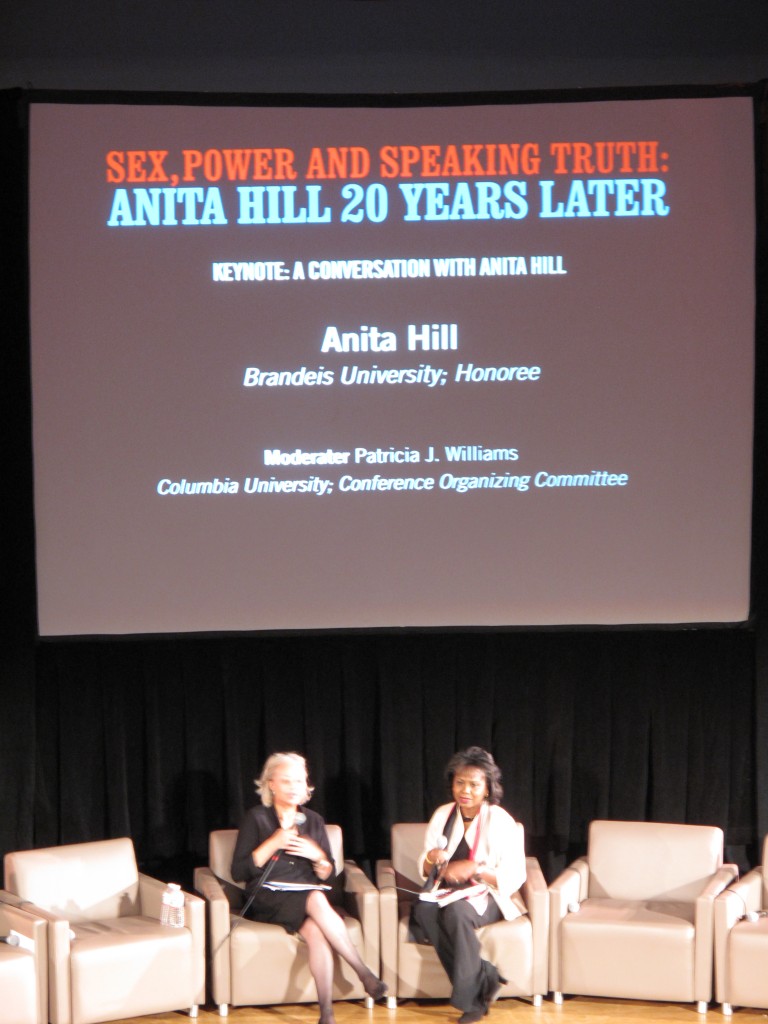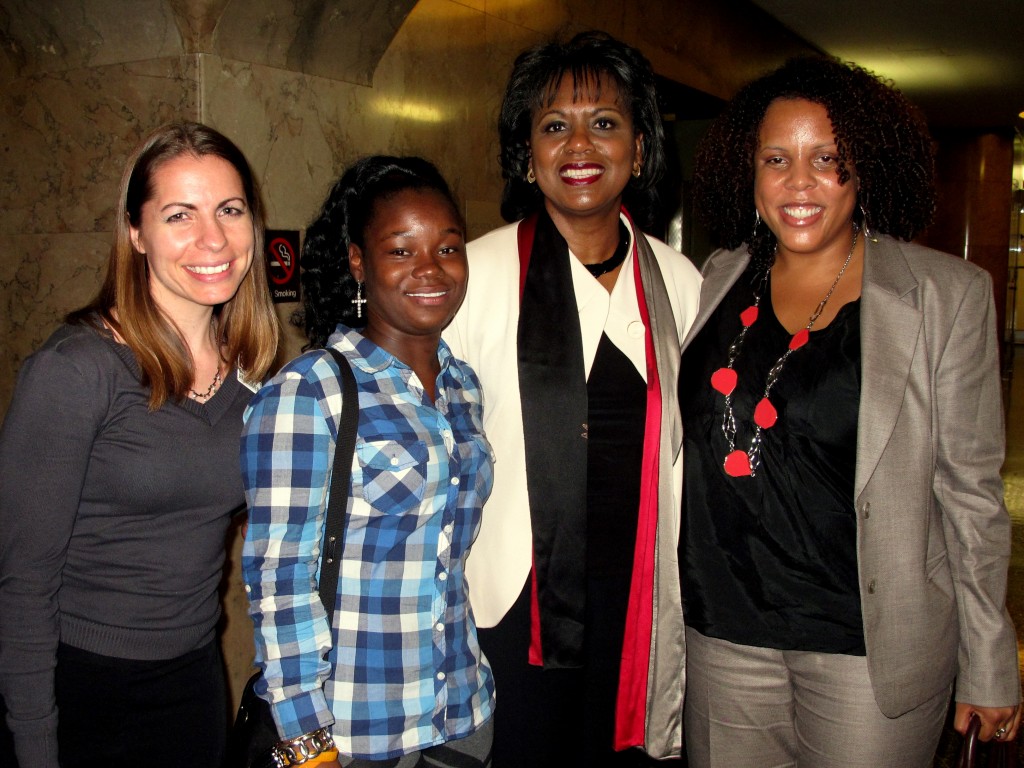Charles Ogletree, a professor at Harvard Law School and the lead counsel for Anita Hill in 1991 spoke those words yesterday at the moving conference Sex, Power and Speaking Truth: Anita Hill 20 Years Later at Hunter College in New York City.
I agree. We all can stand up today as she did then. But, as I discuss in the latter part of the post, the knowing how to stand up in a way that will be effective and have a lasting-impact is often challenging.
The Conference
 Throughout the conference, renowned lawyers, academics, and activists offered history lessons focused on what happened 20 years ago, commentary about the impact it had on current events and organizing efforts, and ideas for addressing sexual harassment in the future (though I thought the latter was a bit light on realistic ideas.)
Throughout the conference, renowned lawyers, academics, and activists offered history lessons focused on what happened 20 years ago, commentary about the impact it had on current events and organizing efforts, and ideas for addressing sexual harassment in the future (though I thought the latter was a bit light on realistic ideas.)
We watched a compelling clip from Sex & Justice showing what happened 20 years ago and participated in lunchtime discussions on sexual harassment sub-topics.
If you missed it, you can watch most the conference online at C-Span.org.
To give you a taste of the day, here are some of my notes from two of the three panels and from Hill’s keynote address:
1. Charles Ogletree, Harvard Law School spoke first. He represented Anita Hill in 1991.
“What she stood for in 1991 still resonates with us…she’s in a class with Susan B. Anthony, Rosa Parks, Eleanor Roosevelt, Fanny Lou Hamer…”
Despite all of the backlash he and Hill faced, his then 12-year-old daughter told him on the phone, “I believe Anita.”
2. Lani Guinier, Harvard Law School
She talked about how Anita Hill made people “deal with the ambivalence and ignorance of the question: ‘Are you black or are you a woman?'”
“Many of us realized that not all women are white, not all blacks are men, and some of us, like Anita Hill, are very brave.”
3. Judith Resnik, Yale Law School
She examined the context of the hearing…how the male Senators on the hearing committee didn’t want to let Hill speak and then cut her defense short. While Thomas should have been on trial, they made it so Hill was.
It’s with the work of Hill and others who stood up for her and spoke out against sexual harassment that “things that are seen as ‘the way things are’ become intolerable”
4. Catharine A. MacKinnon, University of Michigan Law School
She’d been speaking out against sexual harassment since the 1970s and wrote the first book on it in 1979. During the hearing, she gave commentary on NBC.
The hearing was a “massive consciousness raising session” on an issue she’d been trying to raise awareness about for years..the hearing “made sexual harassment real to people” in a way her 1979 book did not, the EEOC guidelines did not, etc…only Anita Hill did.
“Women identified with Anita Hill…they believed her with ferocity and more said so as time and heat passed. They realized what happened to them was often as bad as what happened to her and if she could do it, they could do it too.”
“Sometimes it’s important to stand up and do the right thing, even if you lose,” she said about the DSK-Diallo sexual assault case.
5. Jamia Wilson, Women’s Media Center
“I am not Anita Hill but I could have been and that scares the crap out of me.”
Thelma & Louise + Anita Hill introduced her to victim-blaming and rape shaming. She witnessed the hearings become “a modern day witch hunt rather than the high tech lynching, as Thomas said.”
She feared she could be marked a traitor [against her race] for one day speaking out. The hearing was “intersectionality 101” for her.
 6. The keynote address was a conversation between Patricia J. Williams and Hill. Here are a few notes from it:
6. The keynote address was a conversation between Patricia J. Williams and Hill. Here are a few notes from it:
Anita Hill spoke about the death threats, bomb threats, sh*t people mailed her and how she had to go to the grocery store knowing 7 in 10 people thought she had perjured herself…and how her family and friends helped her through it.
She talked about wanting to get her life back and resented that things didn’t go back to normal after the hearing ended. She said once she let go of that (about 6 months later) and realized she had a different life and she had to decide what shape that life would take, then she was able to move forward and also recognize that while it was an important event that shaped her life, it was just an event.
In her new book Reimagining Equality: Stories of Gender, Race, and Finding Home she writes about home and also the housing crisis in the USA.
Some of the last things she said related to her work on sexual harassment as she “helps people find their voice, talk about the issues that keep people from living full lives of equality…we should imagine a future where sexual harassment no longer exists”
7. Kimberlé Crenshaw, The African American Policy Network (You can read her speech in the current issue of The Nation).
She spoke a lot to the issue of intersectionality of race and gender. She said the message still is “just get over it” re: sexual harassment, but “until we say it’s over, it’s not over.”
8. Virginia Valian, Hunter College
She shared stats on sexual harassment in the workplace…they’re the same today as they were 20 years ago.
She said there are several calls to action, including: 1) be smarter about how we influence people in power and how we get them into power. educate judiciary, lawyers, lawmakers, and be more systematic in our efforts 2) Form rapid response teams so we can influence the media and get the correct facts out. Giving good info to the people in power immediately.
9. Gloria Steinem
She talked about the DSK case and how the work of Hill and others allowed Nafissatou Diallo to come forward to report him. Both lost in the courts but they won in public opinion…Most importantly, this is the legacy of Anita Hill: “Thomas is on the Supreme Court but DSK will never be president of France!”
“We have the strength to go forward”
10. Devon Carbado, UCLA School of Law
“What have we learned from the Thomas-Hill hearings? That our anti-racism needs to be tied to a robust feminism and our feminist interventions must be infused with anti-racism.”
11. Julie Zeilinger, FBomb
“Gender conditioning and gender stereotyping allow sexual harassment to continue.”
“Our work isn’t yet done, plenty of us are willing to continue the fight and take Anita Hill’s legacy and run with it.”
It was a day I will never forget. Especially after I had the huge honor of meeting both Steinem and Hill at an evening reception. I got to meet Hill with Joanne Smith, founder and ED of Girls for Gender Equity and one of her organizers Jodyann. Jodyann was determined to get to meet Hill and was overcome with emotion when she did. It was moving.
I’m still feeling the adrenaline and awe f meeting two feminist icons in one evening on top of meeting and reconnecting with amazing current activist/future feminist icons.

What to Take Away
The conference is over. What now?
Let’s look back to Ogletree’s quote. “Anita Hill stood up in 1991 and we can all stand up in 2011.”
If you’re reading this blog, you probably want to (and do) stand up against sexual harassment—especially the kind that happens in public places—and ideally, you’d like to do so to the same extent that Anita Hill stood up against workplace sexual harassment.
But, if you’re like me, you may find that figuring out what actions will work, what efforts will be effective, and what kind of collective organizing will create long-term change is challenging. It’s especially challenging since “street harassment” is not a universal term and it’s not seen as a legitimate problem by most people. We’re still at the consciousness-raising and education stage.
To help with that stage, sites like HarassMap, Hollaback and mine collect individuals’ stories of resistance to street harassment, people write articles, tweet, and post stories on Tumblr, and numerous groups and people organize community anti-street harassment efforts. But I just don’t think they are enough to really turn street harassment into an immediately-recognized issue that is treated as seriously as workplace sexual harassment, or at least not any time soon. There must be more we can collectively do about street harassment that is inclusive, appropriate, and effective; or one major action we can rally behind to raise awareness as people rallied behind Anita Hill. But what is it?
Something I’m taking away from the conference is a better understanding of the workplace anti-sexual harassment movement and I hope that as I reflect on all that I’ve learned, I may come across ideas for effective, inclusive ways we can stand up against street harassment.
A related conference take away for me is a desire to learn even more about the general anti-sexual harassment movement and see what messaging, campaigns, and laws work. I know a lot of people still treat sexual harassment as a joke and it’s still a big problem at work and schools, but at least you don’t get blank stares from decision makers, academics and regular people when you bring it up (as happens with street harassment).
While learning about the anti-sexual harassment movement is not new to me, I’ve never delved very far into it. As my first step, I’m half-way through Carrie Baker’s fascinating and well-documented book, The Women’s Movement Against Sexual Harassment. Attending the Anita Hill conference was another step and now, for my next step, I plan to connect with scholars and activists I heard and met there.
Questions for You
If you attended the conference, what are your takeaways?
And, a question for anyone, do you have thoughts about what we in the anti-street harassment “movement” can learn from Anita Hill and related efforts to end workplace sexual harassment?

 Twenty years
Twenty years